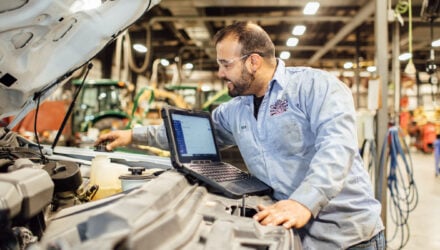
EXPERT: Pete McAllister, of Intelligent Car Leasing
In our latest Expert Blog, Pete McAllister, of Intelligent Car Leasing, tells us how advancements of the future can help you fulfil your health and safety obligations…
Safety features are becoming more advanced in cars over time; this is true for innovative new developments and improvements on old ones.
Keeping drivers and passengers safe has always been a primary concern for manufacturers and this is in no way going to change going forward.
The future holds some pretty impressive new developments, not only to keep us safe in the event of a collision, but to monitor our overall health and wellbeing.
This is great news for fleet managers as keeping employees and drivers healthy is a big issue from both an in-house and legislative standpoint.
If you can keep your workforce healthier then absence levels can be lowered and productivity increased.
This article will look at some of the technological developments in the pipeline and how they may help your business.
First up are pre-collision systems (PCS), these monitoring systems were first introduced by Lexus ten years ago.
A PCS works by collating the incoming data from multiple sensory inputs on the car to detect whether the driver is at risk of a collision.
The first versions of these were simple only picking up on very obvious signs of danger/distress.
However today’s versions (and those in the future) are now using much more subtle inputs to determine a possible collision situation.
For example, eye tracking to tell if the driver is drowsy, lane tracking with auto steering adjustment and alerts to stop if changes in the driver’s control/responsiveness occur.
The systems for immediate dangers still exist obviously; it’s just that they are becoming layered with more subtle monitoring systems as well.
Things like blackouts or seizures are a good example of top level risk situations; where the car would respond to a sudden change in driving that poses danger.
Depending on the situation the car may adjust steering, slow down safely or a combination of these two solutions to avoid a collision.
The systems mentioned above are to do with curbing immediate danger of collisions, but there are many more developments in place to aid our long term health too.
One possibility that seems to be a recurring suggestion is the use of pulse monitoring through the steering wheel.
The possibilities for this would be quite vast, allowing the car to notice any long term trends that may be affecting the driver.
The car would actually be able to pick up on an irregular heartbeat, increases in heart rate and other similar occurrences.
Such technology would also be able to pick up on more imminent dangers such as a heart attack and control the vehicle accordingly.
What then do these systems mean to fleet managers and businesses with multiple driving employees?
They mean that the scope for keeping the workforce healthy and safe is greatly increased.
The company could be alerted early of any developing trends that may warrant suggesting an employee go for a doctor’s check-up.
Doing so could prevent a serious illness/incident further down the line which is beneficial to all parties involved.
There is however the question of whether such practices are invasive?
Not all employees and drivers will want to have so much monitoring systems in place; even if they are for their own benefit.
Therefore companies using vehicles which utilise such systems in the future will need to take such considerations into their vehicle acquisition process.
It is a very contentious subject as to how far into employee’s health matters employers can delve.
Current practices like employee drug testing which currently go on in some companies produce widely divided opinions.
Health monitoring systems in cars will probably not be as controversial, but some may perceive it another step towards the big brother state?
To conclude, we can see that there are some pretty interesting developments in the pipeline.
The systems discussed in this article are ones that are realistically viable and currently being tested/developed.
Besides this, there are obviously all the usual science fiction type systems being talked about, examples include puffing pungent fragrances into the cabin to keep drivers alert.
But the likelihood of these actually coming to fruition is small.
Keep a close eye out, as within the next 5-10years the automotive market expects to see a real rise in the use of smart technologies to monitor driver health vitals.
After which drivers will be a lot safer without actually having to take any additional active measures.






















